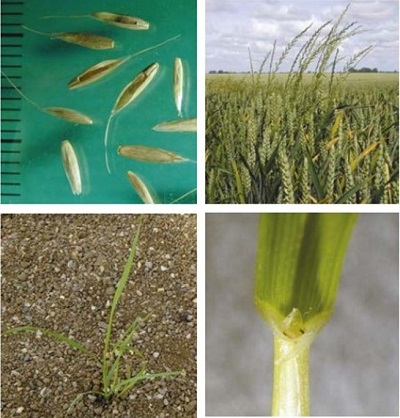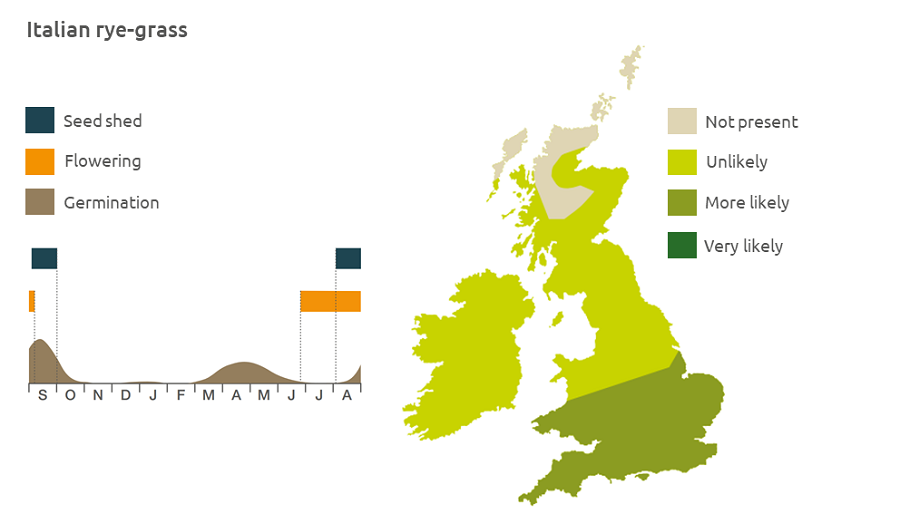- Home
- Knowledge library
- Distribution, biology and management of Italian rye-grass in the UK
Distribution, biology and management of Italian rye-grass in the UK
Italian rye-grass is a grass weed found mainly in southern Britain, with herbicide resistance widespread. Find out how to identify and control it.
Overview
- Italian rye-grass (Lolium multiflorum) is an economically important forage grass
- It can become a severe weed in arable crops where pasture forms part of the rotation
- However, it is often reported in fields with no known or no recent history of forage/livestock in the system
- It grows from seed or vegetatively (from badly ploughed-in tufts or rooting stems)
- Autumn-germinating plants can overwinter
- It is particularly competitive in winter wheat and winter oilseed rape
- Some populations are associated with herbicide resistance
Weed Resistance Action Group (WRAG)
Description
It is a leafy annual or biennial grass, 30–100 cm tall. The stems are tufted or solitary with an upright or spreading habit and green hairless leaves. Italian rye-grass tends to be larger, stouter and more densely tufted than perennial rye-grass.
Key features
Plant: It is distinguished from perennial rye-grass by the leaves which are rolled in the shoot and the large auricles.
Flowers: The lower bract is awned. Flowerheads are arranged at 90 degrees to the flower stem.

Location and life cycle

Geographic distribution
Italian rye-grass is mainly found in the south of Britain, on verges and field borders, mainly in lowland areas at altitudes below 400 m.
Soil type
It prefers well-drained soils of a moderate pH and high nitrogen.
Seed statistics
- Seed longevity: >5 years
- Seed weight: 2.5 mg
- Seeds/head: 100
Management
Rye-grass produces more seeds per plant than black-grass and is, at least, as competitive. High levels of control are needed.
Autumn-emerging plants produce about 23 times as much seed as spring-emerging ones. As a result, weed control should focus on autumn, rather than spring, treatments.
Seed dormancy is short-lived. Peak germination occurs in autumn-sown crops two to three weeks after the soil surface becomes thoroughly moist. Most seed emerges by November. The few plants emerging in spring will not thrive or set much seed in a vigorously growing autumn-sown cereal crop. However, in spring crops, the weed can thrive and produce a significant level of seed return. This sets it apart from black-grass.
For advice on herbicides, please speak with your agronomist or adviser.
Herbicide resistance
- An increasing threat throughout the UK
- Resistance first found 1990
- Cases confirmed over 475
- Number of counties 33
- Non-target site resistance – common
- Target site resistance to ‘fops’, ‘dims’ and ‘dens’ – occurs, but less commonly than in black-grass
- Target site resistance to ALS inhibitors (confirmed in 2012)
- 2019 survey of resistance status suggested resistance is continuing to increase
- 2021 survey found evidence of increasing control issues, with problematic hotspots widespread across the UK
- 2025 saw the first case of glyphosate resistance confirmed (the first in any UK weed species)
Herbicide resistance is present in some rye-grass populations. The issue is widespread, but less problematic than with black-grass.
The extent and expression of resistance may vary according to the origin of weed infestations, and the history of herbicide use on the farm.
Resistance poses an increasing threat due to over-reliance on high resistance risk herbicides (ACCase and ALS inhibitors).
First case of glyphosate resistance in a UK weed (Italian rye-grass) confirmed (2025 news)
An update on herbicide resistance in Italian rye-grass (Agronomists' Conference 2021)
The growing challenge of herbicide resistant Italian rye-grass (article)
Findings from research studies
- Resistance to cycloxydim and pinoxaden was found in under 20% of farms
- Resistance was mainly due to enhanced metabolism, although ACCase target site resistance was also detected
- Resistance to ALS-inhibiting herbicides is likely to increase
Actions
- Reduce seed spread by cleaning equipment between fields
- Avoid fields with heavy rye-grass populations
- Delay sowing wheat to reduce infestations
- Aim to achieve effective chemical control in autumn
- Use glyphosate but follow resistance management guidance
- Consider a control programme based on both pre- and post-emergence herbicides
- Apply post-emergence herbicides in autumn, at the earliest opportunity, according to label recommendations and soil-moisture status
- Rotate herbicides applied over successive seasons to minimise resistance risk
- If resistance is suspected, have a seed or plant sample tested
When was this information last updated?
This page is based on content from the encyclopaedia of arable weeds publication. Since it was first released in 2008, the publication has been redesigned several times but not revised. However, it remains a good foundation for general information on the distribution and biology of weeds.
Topics:
Sectors:
Tags:

